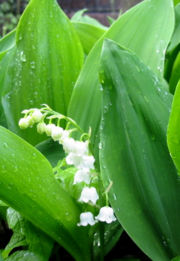Convallaria majalis - Lily of the Valley
Scientific Name: Convallaria majalis
Common Name: Lily of the Valley or Lily-of-the-Valley
Cultural Information: Plant the growing tip of the rhizome just below soil level in a well-prepared bed. The foliage begins to go dormant by early fall, dying completely to the ground.
Thomas Jefferson recorded lily-of-the-valley as early as 1771 in a list of hardy perennial flowers suitable for Monticello.[1] He also ordered roots from Bernard McMahon in 1809.[2]
This well-known flower, native to Great Britain, is a universal favorite and has been in gardens since the 16th century.[3] Williamsburg's John Custis first mentioned lily of the valley around 1738, and by 1829, flowers in white, double white, and rose red were known.[4] In the late 19th century it became an important florist flower and was produced in immense quantities.
Lily of the valley is a hardy, herbaceous, late-spring-flowering perennial with fragrant, nodding, white, bell-like flowers and large, dark green, lance-like foliage. The plant was used to help with headaches, hysteria, fainting, sprains, cholic, and love potions.[5]
- Peggy Cornett, n.d.
Primary Source References
1808 December 19. (Ann Cary Randolph Bankhead to Jefferson). "I would be much obliged to you if you will send me in a letter some of the ice plant seed a Lady here has Lost it & is to give me a few roots of the Lilly of the valley ...."[6]
Further Sources
- Adams, Denise Wiles. Restoring American Gardens: An Encyclopedia of Heirloom Ornamental Plants, 1640-1940. Portland, Oregon: Timber Press, Inc., 2004.
- Thomas Jefferson Center for Historic Plants.
References
- ^ Garden Book, 1766-1824, page 7, by Thomas Jefferson [electronic edition], Thomas Jefferson Papers: An Electronic Archive (Boston: Massachusetts Historical Society, 2003). See also Betts, Garden Book, 24.
- ^ Edwin M. Betts, Hazlehurst Bolton Perkins, and Peter J. Hatch, Thomas Jefferson's Flower Garden at Monticello, 3rd ed. (Charlottesville: University Press of Virginia, 1986), 57.
- ^ David Stuart and James Sutherland, Plants from the Past: Old Flowers for New Gardens (London: Penguin Books, 1989), 107.
- ^ Ann Leighton, American Gardens in the Eighteenth Century (Amherst: University of Massachusetts Press, 1986), 410.
- ^ Stuart and Sutherland, Plants from the Past, 107; Alice M. Coats, Flowers and Their Histories (London: Black, 1968), 57.
- ^ Coolidge Collection of Thomas Jefferson Manuscripts, Massachusetts Historical Society. Transcription available at Founders Online.
